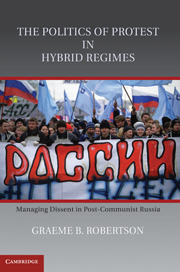Book contents
- Frontmatter
- Contents
- List of Tables
- List of Figures
- Acknowledgments
- Introduction
- 1 Protest and Regimes
- 2 Protest and Regime in Russia
- 3 The Geography of Strikes
- 4 A Time for Trouble
- 5 Elections and the Decline of Protest
- 6 Vladimir Putin and Defeat-Proofing the System
- 7 Protest, Repression, and Order from Below
- 8 Implications for Russia and Elsewhere
- Bibliography
- Appendix 1 Event Protocol
- Appendix 2 Sectoral and Seasonal Strike Patterns
- Appendix 3 A Statistical Approach to Political Relations
- Index
7 - Protest, Repression, and Order from Below
Published online by Cambridge University Press: 10 January 2011
- Frontmatter
- Contents
- List of Tables
- List of Figures
- Acknowledgments
- Introduction
- 1 Protest and Regimes
- 2 Protest and Regime in Russia
- 3 The Geography of Strikes
- 4 A Time for Trouble
- 5 Elections and the Decline of Protest
- 6 Vladimir Putin and Defeat-Proofing the System
- 7 Protest, Repression, and Order from Below
- 8 Implications for Russia and Elsewhere
- Bibliography
- Appendix 1 Event Protocol
- Appendix 2 Sectoral and Seasonal Strike Patterns
- Appendix 3 A Statistical Approach to Political Relations
- Index
Summary
“Tatarsky of course hated most of the manifestions of Soviet power, but he still couldn't understand why it was worth exchanging an evil empire for an evil banana republic that imported its bananas from Finland.”
Viktor Pelevin, Generation P.Early Sunday mornings are usually a pleasant, quiet time to stroll the streets of St. Petersburg. On Sunday November 26, 2007, however, one week before nationwide elections to the State Duma, opposition activists were planning a Dissenters' March (marsh nesoglasnykh) to Palace Square in front of the former Winter Palace, and the atmosphere in the city center was busy and intimidating. The main avenues were filled with young men, and the narrow streets leading to Palace Square were blocked with buses and fences. Snow ploughs and garbage trucks blocked the open side of the square. Yet the large number of people on the streets, up to 10,000 by some estimates, were certainly not “dissenters.” Instead the streets teemed with men in the blue-gray uniforms of the Interior Ministry (MVD), some disguised by masks beneath their helmets, and many wearing the insignia of the elite special unit OMON.
Dissenters, by contrast, were hard to find. Opposition leaders Ol'ga Kurnosova of the United Civil Front (Ob”edinennyi grazhdanskii front, OGF), Leonid Gozman of the Union of Right Forces (Soiuz pravykh sil, SPS), and Maksim Reznik of the political party Iabloko, had spent the night at the Iabloko offices in an attempt to avoid preemptive arrest.
- Type
- Chapter
- Information
- The Politics of Protest in Hybrid RegimesManaging Dissent in Post-Communist Russia, pp. 167 - 199Publisher: Cambridge University PressPrint publication year: 2010



